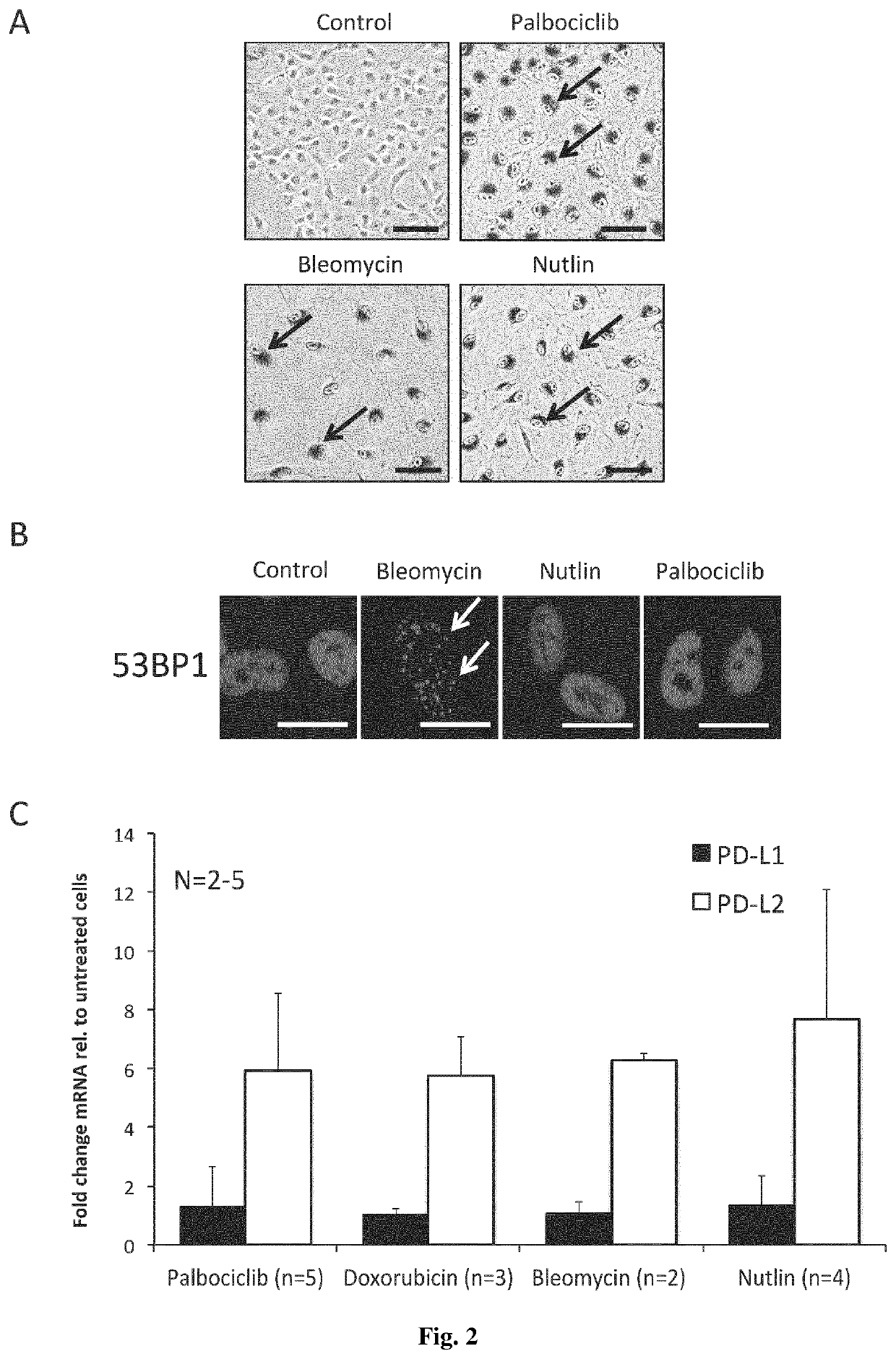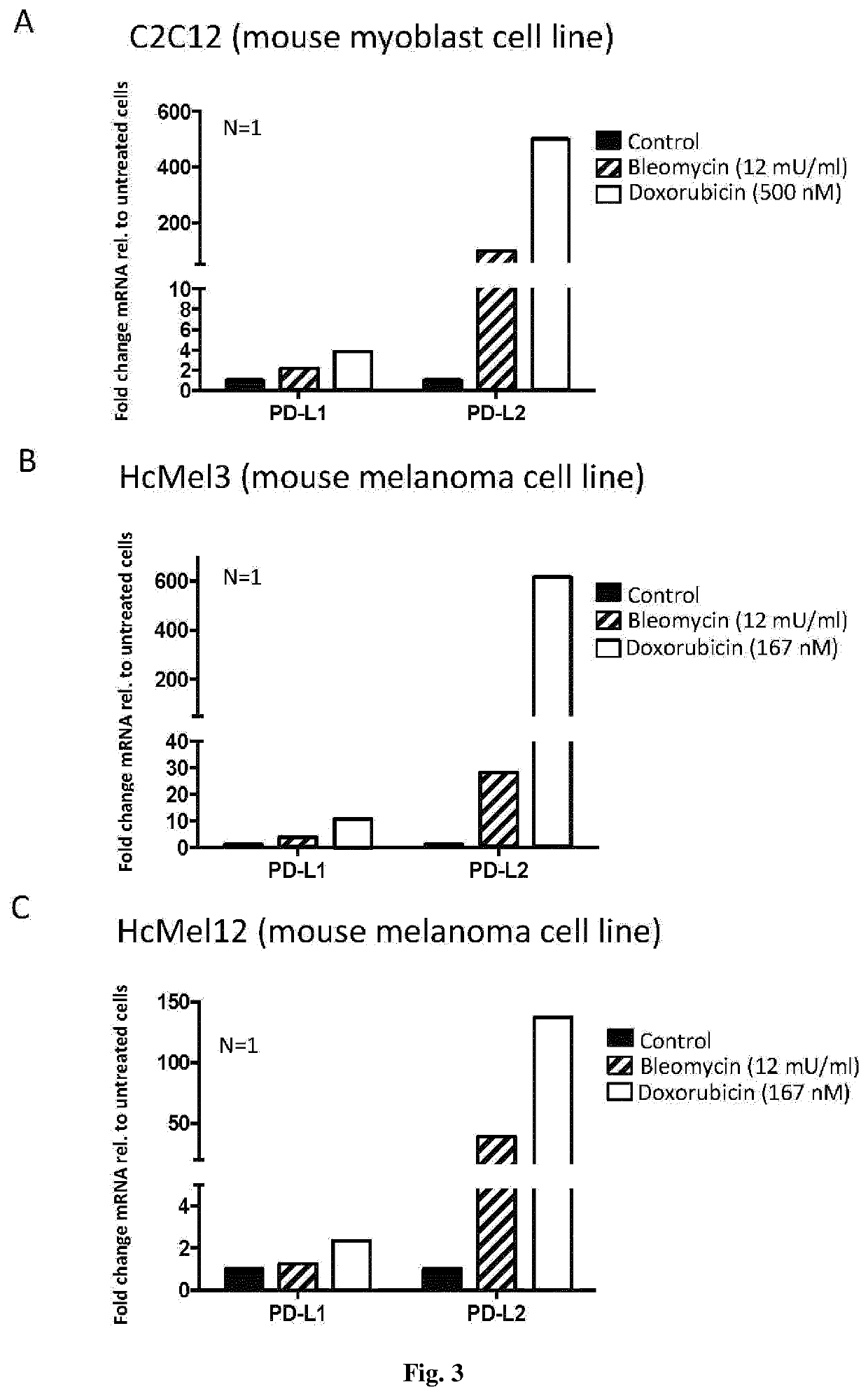Identification and elimination of damaged and/or senescent cells
- Summary
- Abstract
- Description
- Claims
- Application Information
AI Technical Summary
Benefits of technology
Problems solved by technology
Method used
Image
Examples
example 1
in Cultured Cells that PD-L2 is Highly and Preferentially Expressed in Damaged and or Senescent Cells
[0186]The inventors have observed that prolonged treatment of tumor cell lines with palbociclib, a CDK4 / CDK6 specific inhibitor developed by Pfizer, induced phenotypic changes consistent with a senescent response (increased size and flat morphology, cell cycle arrest and increased SA-β gal activity) in a variety of human tumor cells such as the melanoma SK-Mel-103 and head and neck squamous cell carcinoma (HNSCC) SCC38 and SCC42B cell lines (FIGS. 1A and 2A). Under these conditions, senescent cells showed up-regulation of PD-L2 but not PD-L1 mRNA levels (FIGS. 1B and 2C). In addition to palbociclib, the genotoxic drug bleomycin and the Mdm2 inhibitor nutlin, induce senescence in the SK-Mel-103 cells (FIG. 2A) and had a similar effect on PD-L2 mRNA levels (FIG. 2C). Since neither palbociclib nor nutlin caused DNA damage in these cells, as evidenced by the absence of 53BP1 foci in the ...
example 2
in Preclinical Models of Lung and Kidney Fibrosis that PD-L2 is Highly and Preferentially Expressed in Damaged and or Senescent Cells
[0188]Fibrotic pathologies, including lung and kidney fibrosis have been recently linked to the occurrence of senescence. The inventors used mice models of these diseases to study the regulation of PD-L2 in vivo. Lung fibrosis was induced in mice by intratracheal delivery of a single dose of bleomycin. Kidney fibrosis was caused by the surgical obstruction of the ureteral conduct. Both lung and kidney fibrosis resulted in the accumulation of senescent cells as revealed by the detection of SA-β galactosidase positive staining in tissue samples from fibrotic kidneys (FIG. 4A) and in whole fibrotic lungs (FIG. 5A). In the model of kidney fibrosis, this was reinforced by the transcriptional up-regulation of two well-characterized senescent markers: p21 and IL-6, in fibrotic organs (FIG. 4B). In agreement with the inventors' previous observations, they foun...
example 3
in Preclinical Models of Chemotherapy that PD-L2 is Highly and Preferentially Expressed in Damaged and or Senescent Cells
[0189]In vivo treatment with palbociclib, delivered by oral gavage, was shown to halt the growth of mouse xenografts of the human melanoma cell line SK-Mel-103 (FIG. 6A). This CDK4 / CDK6 inhibitor induced a strong senescent response as evidenced by the intense staining of whole tumors and tumor sections (FIG. 6B). Increased SA-β galactosidase activity strongly correlated with the absence of Ki67 positive proliferative cells (FIG. 6B). When SK-Mel-103 xenografts were analyzed for PD-L1 and PD-L2 expression, the inventors observed that PD-L2 mRNA was selectively up-regulated in xenografts from palbociclib-treated mice (FIG. 7A). Accordingly, PD-L2 protein levels are also increased in senescent tumors (FIG. 7B).
PUM
| Property | Measurement | Unit |
|---|---|---|
| Therapeutic | aaaaa | aaaaa |
| Level | aaaaa | aaaaa |
Abstract
Description
Claims
Application Information
 Login to View More
Login to View More - R&D
- Intellectual Property
- Life Sciences
- Materials
- Tech Scout
- Unparalleled Data Quality
- Higher Quality Content
- 60% Fewer Hallucinations
Browse by: Latest US Patents, China's latest patents, Technical Efficacy Thesaurus, Application Domain, Technology Topic, Popular Technical Reports.
© 2025 PatSnap. All rights reserved.Legal|Privacy policy|Modern Slavery Act Transparency Statement|Sitemap|About US| Contact US: help@patsnap.com



